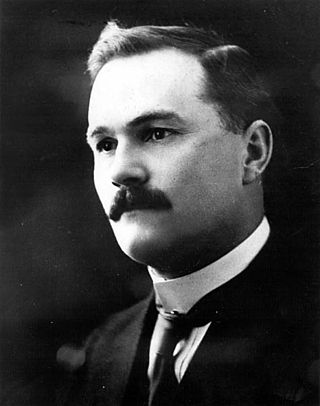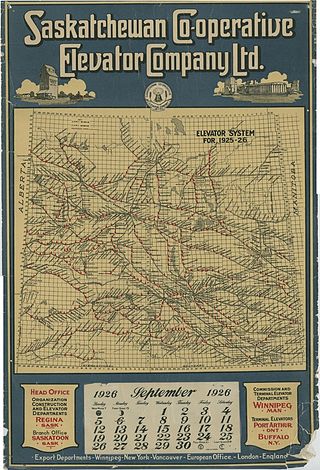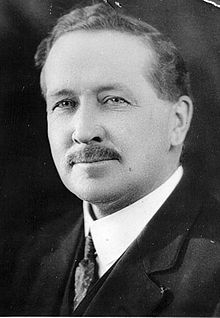The Progressive Party of Canada, formally the National Progressive Party, was a federal-level political party in Canada in the 1920s until 1930. It was linked with the provincial United Farmers parties in several provinces, and it spawned the Progressive Party of Saskatchewan, and the Progressive Party of Manitoba, which formed the government of that province. The Progressive Party was part of the farmers' political movement that included federal and provincial Progressive and United Farmers' parties.

Charles Avery Dunning was the third premier of Saskatchewan. Born in England, he emigrated to Canada at the age of 16. By the age of 36, he was premier. He had a successful career as a farmer, businessman, and politician, both provincially and federally.

Agricore United was a farmer-directed agribusiness in Canada. It supplied crop nutrition and crop protection products, and offered grain handling and marketing services. It was created on November 1, 2001 by the merger of Agricore and United Grain Growers. It was headquartered in Winnipeg, Manitoba. Its shares were publicly traded on the Toronto Stock Exchange (TSX) under the symbol "AU" until June 15, 2007, when it was taken over by the Saskatchewan Wheat Pool. Agri-business giant Archer Daniels Midland (ADM) had a 28% stake in the company at the time of the takeover.

Sintaluta is a town in Saskatchewan, Canada. The population of Sintaluta is approximately 119 people according to the 2016 Canadian Census. The town is located about 85 km east of Regina. The town is on the north side of the Trans-Canada Highway.

The Saskatchewan Wheat Pool was a grain handling, agri-food processing and marketing company based in Regina, Saskatchewan. The Pool created a network of marketing alliances in North America and internationally which made it the largest agricultural grain handling operation in the province of Saskatchewan. Before becoming Viterra, SWP had operated 276 retail outlets and more than 100 grain handling and marketing centres. The Saskatchewan Wheat Pool operated under the name of AgPro in the prairie provinces of Manitoba and Alberta. Begun as a co-operative in the 1920s, the company became a publicly traded corporation in the 1990s. After the 2007 takeover of its competitor, Winnipeg-based Agricore United, the Pool name was retired. The merged company operated under the name Viterra until 2013, when it was acquired by Glencore International.

John Archibald Maharg was a Saskatchewan politician.
The Progressive Party of Saskatchewan was a provincial section of the Progressive Party of Canada and was active from the 1920s to the mid-1930s. The Progressives were an agrarian, social democratic political movement. It was originally dedicated to political and economic reform; it also challenged economic policies that favoured the financial and industrial interests in Central Canada over agrarian interests. Like its federal counterpart it favoured free trade over protectionism.
Charles William Gibbings (1916-2009) was born on a farm near Rosetown, Saskatchewan, Canada on August 10, 1916. After earning a BSc in Agriculture at the University of Saskatchewan, Gibbings taught at the University's School of Agriculture and conducted youth training programs across the province, both while continuing to farm.

Manitoba Pool Elevators was a grain trade company founded in 1924. It became a subsidiary of the Saskatchewan Wheat Pool until November 1932, when the Pool declared bankruptcy. In 1998 Alberta Wheat Pool and Manitoba Pool Elevators merged to form Agricore Cooperative Limited. In 2001, United Grain Growers combined its business operations with Agricore Cooperative Ltd. and carried on business as Agricore United, a publicly traded company, no longer a farmer-owned cooperative. In 2007, Agricore United was taken over by the Saskatchewan Wheat Pool, another publicly traded company. The merged corporation was renamed Viterra.
The Manitoba Grain Growers' Association (MGGA) was a farmer's association that was active in Manitoba, Canada, in the first two decades of the 20th century. It provided a voice for farmers in their struggle with grain dealers and the railways, and was influential in obtaining favorable legislation. The MGGA supported the Grain Growers' Grain Company, a cooperative of prairie farmers, and its organ the Grain Growers' Guide. At first it remained neutral politically, but in 1920 it restructured as the United Farmers of Manitoba in preparation for becoming a political party.
The Territorial Grain Growers' Association (TGGA) was a farmer's association that was active in Western Canada at the start of the 20th century, in what was then the Northwest Territories and later became Saskatchewan and Alberta. It provided a voice for farmers in their struggle with grain dealers and the railways, and was influential in obtaining favorable legislation. After Alberta and Saskatchewan became provinces the TGGA was succeeded by the Alberta Farmers' Association and the Saskatchewan Grain Growers' Association.
The Alberta Farmers' Association (AFA) was a farmer's association that was active in Alberta, Canada from 1905 to 1909. It was formed from the Alberta branch of the Territorial Grain Growers' Association (TGGA) when Alberta became a province in 1905. It provided a voice for farmers in their struggle with grain dealers and the railways. In January 1909 it merged with the Canadian Society of Equity to form the United Farmers of Alberta.

Edward Alexander Partridge was a Canadian teacher, farmer, agrarian radical, businessman and author. He was born in Ontario but moved to Saskatchewan where he taught and then became a farmer. He was active in the Territorial Grain Growers' Association (TGGA), founded in 1902, which addressed various problems with the Western Canada grain market. He founded the cooperative Grain Growers' Grain Company, the predecessor of the United Grain Growers, and the Grain Growers' Guide, a widely distributed weekly paper. His "Partridge Plan" was a broad and visionary proposal for addressing a wide range of farmers' issues, eliminating many abuses caused by the near-monopoly of grain elevator companies, and resulted in important reforms by the provincial governments. Patridge was named a National Historic Person in 2018.

The Grain Growers' Guide was a newspaper published by the Grain Growers' Grain Company (GGGC) in Western Canada for grain farmers between 1908 and 1936. It reflected the views of the grain growers' associations. In its day it had the highest circulation of any farm paper in the region.

George Fisher Chipman was a Canadian journalist who edited the Grain Growers' Guide for many years. The paper was the official organ of the provincial grain growers' associations in the Canadian prairies, and became the mostly widely circulated farmers' paper in the region.

The Grain Growers' Grain Company (GGGC) was a farmers' cooperative founded in the prairie provinces of western Canada in 1906. The GGGC met strong resistance from existing grain dealers. It was forced off the Winnipeg Grain Exchange and almost failed. With help from the Manitoba government it regained its seat on the exchange, and soon had a profitable grain trading business. The company founded the Grain Growers' Guide, which became the most popular farmer's newspaper in the region. In 1912 the GGGC began operating inland and terminal grain elevators, and in 1913 moved into the farm supply business. The GGGC was financially secure and owned or operated almost 200 elevators as well as 122 coals sheds and 145 warehouses by the time it merged with the Alberta Farmers' Co-operative Elevator Company to form the United Grain Growers in 1917.

James William Scallion was an Irish-born Canadian teacher, farmer and agrarian activist. He was the founder of the Manitoba Grain Growers' Association.

The Manitoba Grain Act was an act passed by the Federal government of Canada in 1900 to protect the interests of grain farmers against abuses by the grain storage and trading companies and the railways. Although well-intentioned the act was flawed, and a series of amendments were required before the more effective Canada Grain Act of 1912 was passed.

The Saskatchewan Co-operative Elevator Company (SCEC) was a farmer-owned enterprise that provided grain storage and handling services to farmers in Saskatchewan, Canada between 1911 and 1926, when its assets were purchased by the Saskatchewan Wheat Pool.

The Alberta Farmers' Co-operative Elevator Company (AFCEC) was a farmer-owned enterprise that provided grain storage and handling services to farmers in Alberta, Canada between 1913 and 1917, when it was merged with the Manitoba-based Grain Growers' Grain Company (GGGC) to form the United Grain Growers (UGG).
















